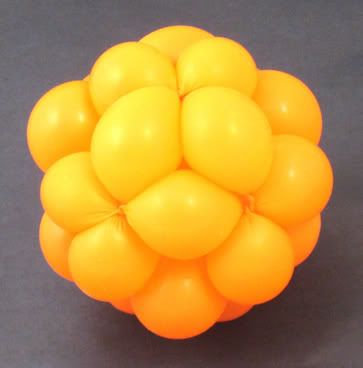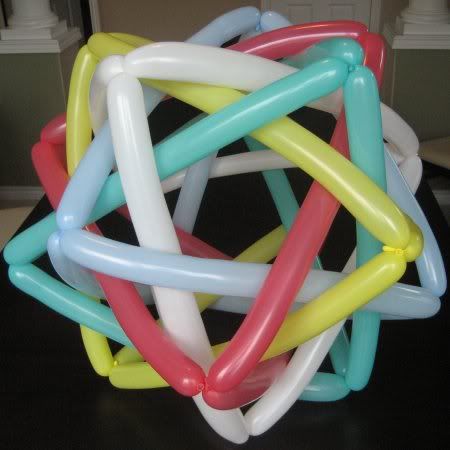
Posted on 03/28/2010 1:40:12 AM PDT by bruinbirdman
Inside the world of Grigory Perelman: the man who solved the world's toughest maths problem proves to be a puzzle himself.

He has been called "the cleverest man in the world" and shook academia to its foundations when he announced he had solved a fiendish mathematical problem that had baffled the planet's best brains for a century.
Yet Grigory Perelman, a 43-year-old Russian mathematician, has consciously spurned plaudits and wealth to subsist like a hermit. He lives in a 2-bedroom flat with his elderly mother in a dilapidated Soviet-era tower block in St. Petersburg, while neighbours complain that his own studio flat, which he seldom uses, has become a breeding ground for cockroaches.
Now he has proved again, and in spectacular fashion, that he despises society's conventional norms. Picking up the telephone last week, the bearded genius, who is jobless, found himself being offered an academic prize worth $1 million.
He politely but tersely told the prestigious American institute offering him the prize that he would have to consider whether he wanted to accept the money or not.
"He said he would let me know at some point," Jim Carlson, President of the Clay Mathematics Institute, told The Sunday Telegraph.
"He did not give a sense of timing but I do not expect it will be tomorrow. He is more than extremely brief. He does not say too much," he added, explaining that Mr Perelman had not said why he would need to think about such a windfall.
"It is not every day that a person even entertains turning down a million dollars."
The Russian has turned down high honours before. In 2006, he was offered and declined the Fields Medal, the mathematical world's equivalent of a Nobel Prize. He said at the time he was
(Excerpt) Read more at telegraph.co.uk ...
Speak english please. :)
I'm still dealing with the reason the local tribe on "F Troop" was called the "Howcowya's"
A proposition in topology put forward by Henri Poincaré in 1904. Poincaré was led to make his conjecture during his pioneering work in topology, the mathematical study of the properties of objects that stay unchanged when the objects are stretched or bent. In loose terms, the conjecture is that every three-dimensional object that has a set of sphere-like properties (i.e., is topologically equivalent to a sphere) can be stretched or squeezed until it is a three-dimensional sphere (a 3-sphere) without tearing (i.e., making a hole) it. Strictly speaking, the conjecture says that every closed, simply-connected three-manifold is homeomorphic to the three-sphere.
Poincaré proved the two-dimensional case and he guessed that the principle would hold in three dimensions. Determining if the Poincaré conjecture is correct has been widely judged the most important outstanding problem in topology – so important that, in 2000, the Clay Mathematics Institute in Boston named it as one of seven Millennium Prize Problems and offered a $1 million prize for its solution. Since the 1960s, mathematicians have shown by various means that the generalized conjecture is true for all dimensions higher than three – the four-dimensional case finally falling in 1982. But none of these strategies work in three dimensions. On Apr. 7, 2002 came reports that the Poincaré conjecture might have been proved by Martin Dunwoody of Southampton University, but within a few days a fatal flaw was found in his proof. Then, in April 2003, what appears to be a genuine breakthrough emerged during a series of lectures delivered at the Massachusetts Institute of Technology by the Russian mathematician Grigori Perelman of the Steklov Institute of Mathematics (part of the Russian Academy of Sciences in St. Petersburg). His lectures, entitled "Ricci Flow and Geometrization of Three-Manifolds," constituted Perelman's first public discussion of important results contained in two earlier preprints. Mathematicians will now scrutinize the validity of Perelman's work (which does not actually mention the Poincaré conjecture by name). In any event, the Clay Institute calls for a two-year cooling-off period is required before the prize can be awarded.
manifold A mathematical object that, in geometrical terms, is nearly "flat" on a small scale (though on a larger scale it may bend and twist into exotic and intricate forms). More precisely, a manifold is a topological space that looks locally like ordinary Euclidean space. Every manifold has a dimension, which is the number of coordinates needed to specify it in the local coordinate system. A circle, although curved through two dimensions, is an example of a one-dimensional manifold, or one-manifold. A close-up view reveals that any small segment of the circle is practically indistinguishable from a straight line. Similarly, a sphere's two-dimensional surface, even though it curves through three dimensions, is an example of a two-manifold. Seen locally, the surface, like that of a small portion of the Earth, appears flat. A manifold that is smooth enough to have locally well-defined directions is said to be differentiable. If it has enough structure to enable lengths and angles to be measured, then it is called a Riemannian manifold. Differentiable manifolds are used in mathematics to describe geometrical objects, and are also the most natural and general settings in which to study differentiability. In physics, differentiable manifolds serve as the phase space in classical mechanics, while four dimensional pseudo-Riemannian manifolds are used to model spacetime in general relativity.
homeomorphic In topology, two objects are said to be homeomorphic if they can be smoothly deformed into each other.

ONE balloon.
I am better than nothing?
There is certainly a strong cultural element, but in the old nurture vs. nature choice, there seems to be a strong genetic element as well.
One explanation, conjectural, is that in the shtetl the rabbi was the smartest man, and because of support from the community, was able to have the largest family. These smart children multipled.
I notice that Perelman’s engineer father is in Israel. Little Israel has become a scientific and engineering powerhouse, in part by an influx of highly talented Russian Jews.

This is a 4 simplex ONE balloon.
 This is a 5 tetrahedra made of five balloons
This is a 5 tetrahedra made of five balloons
All are assembled according to mathematical structures.
It is the simplest illustration I can think of.
Those are the same Jews who are overwhelmingly liberal.
Well. It took 48 posts to get there. That’s an improvement. Usually it only takes 5 or 6.
Besides, it’s a French conjecture and a Russian hermit.
I don’t think voting patterns on the national scale have anything to do with intelligence or even self interest. they’re mostly identity politics.
politicians have discovered they can plunder all they like as long as they sound like “US”.
I agree. Let’s prove them wrong because they sure don’t sound like us anymore.
Anyway, I thought this thread was about math and all I have done is try to illustrate the point. I don’t know why scientists have to make everything they do sound like the most complicated problem in the universe. It isn’t. It is logic and common sense. I don’t need a long string of numbers to tell me what I already know intuitively. But I guess some people don’t find that “intellectual” enough.
Used to drive my math profs crazy because I could answer the questions and solve the problems in my head but couldn’t stretch it out on a whole sheet of paper. I am dyslexic and cannot deal well with numbers, so I turn them into pictures.
well, the extent of my understanding of math is at best rudimentary —but I think I understand the argument against your point about intuition in this case.
getting the math right enables you to communicate the solution person to person. not just the result but how you got there.
intuition can communicate the result but how you got there—not so much. so its difficult if not impossible to replicate.
math forms the tool kit for doing other stuff.
These days I tell interested middle school students that the money math is algorithms & c++ if they’re interested in writing software and statistics if they’re interested in management.
Limousine liberalism is an effective appeasement strategy for deflecting leftist envy. For a long time the Jews have been the target of murderous envy by leftists. The smarter ones tend to get away, creating a feedback loop of increasing envy and the need for more envy deflection. By making friends with the green eyed monster, they get to be eaten last.
Not what I meant. I can communicate it in words. Just can’t do the numbers. Numbers and mathematical formulas are different. Formulas I can do. Numbers, I will write down wrong even if I am looking straight at them and the answer is right in front of me on a calculator.
If this, then that.
Dyslexia is hard to deal with at times. If I am tired, my words are just as incomprehensible as they can possibly be, even if I have formed them inside my head. Have to double check every post I make for backwards spelling, mixed up letters, and sometimes a string of unrelated letters that don’t even LOOK like a word.
At any rate, as I said earlier, the balloons illustrate the point. Sometimes a picture makes it easier to understand.
No, those are the Jews suffering from the terrible effects of liberalania, a severe mental disorder that makes all your political thoughts and perspectives 180 degrees out of phase with facts and logic.
Yeah. And NONE of us Conservatives who are Orthodox Jews are very smart, I guess. Personally I think liberals of any stripe are certifiably insane.
While you’re here, have a balloon on me.
Chag Same’ach.
I enjoyed this post. Thanks for bringing it to us.
Well, Michael Jordan is absolutely amazing, but 10 bucks he's never experienced a joy of thinking --- what a loss. Somehow, you've never thought this way about Jordan. It's only spiritual people make to think that way.
Well, St. Francis is absolutely amazing, but 10 bucks he's never experienced an LSD high.
Do you see a pattern? To view being laid --- something that rabbits rabbits and squirrels do routinely -- as a measure of achievement is only for feeble minds, like those of rabbits. Humans have always tended to rise to something higher.
He was invited to teach at Berkeley (any other school in the world, from Princeton and Harvard all the way down) would be honored to have him on faculty. What did he do in Berkeley? He saved almost every penny of his salary. Later, people commented, and understood why, he was eating a lot of peanut butter sandwiches. He lived like a student and saved every penny. Later, after returning to Russia, he actually said that those savings will allow him financial independence if he continuous to live frugally. But he does not want any honors because they corrupt.
And he is right. You receive something from a university or an institute, how can you refuse to give a lecture? He will be mobbed to give invited plenary lectures at practically every conference happening in the world. How can you refuse the community that has honored you? In this sense, and most people are simply unaware of how scientific and academic worlds work, awards are NOT free.
He simply does not want to set on that path and continue his life as a thinker.
Disclaimer: Opinions posted on Free Republic are those of the individual posters and do not necessarily represent the opinion of Free Republic or its management. All materials posted herein are protected by copyright law and the exemption for fair use of copyrighted works.